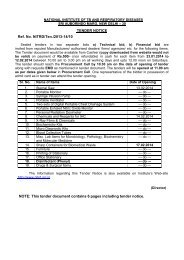The Indian Journal of Tuberculosis - LRS Institute of Tuberculosis ...
The Indian Journal of Tuberculosis - LRS Institute of Tuberculosis ...
The Indian Journal of Tuberculosis - LRS Institute of Tuberculosis ...
Create successful ePaper yourself
Turn your PDF publications into a flip-book with our unique Google optimized e-Paper software.
Original Article Ind. J. Tub., 1992, 39, 21<br />
EFFECT OF ADMINISTRATION OF RIFAMPICIN ON THE<br />
ADRENOCORTICAL FUNCTION IN PATIENTS WITH<br />
PULMONARY TUBERCULOSIS<br />
G. Raghupati Sarma 1 , Chandra Immanuel 2 , P.V. Krishnamurthy 3 , Rani Balasubramanian 3 ,<br />
Geetha Ramachandrari 4 and R. Prabhakar 5<br />
(Original received on 14.2.91; Revised version received on 25.6.91; Accepted on 8.8.91)<br />
Summary. Adrenocortical function was studied on<br />
admission and during treatment in 57 newlydiagnosed<br />
patients with pulmonary tuberculosis<br />
16 <strong>of</strong> whom were treated with a daily regimen<br />
containing Rifampicin (R-7), 22 with a twice<br />
weekly regimen containing; the same drug (11-2)<br />
and 19 with a daily regimen that did not contain<br />
Rifampicin (NR-7). In patients on daily treatment<br />
(R-7 and NR-7), there was a slight increase in<br />
plasma cortisol at 1 week followed by a decline;<br />
while the mean level at 4 weeks was similar to that<br />
on admission in[the R-7 patients, that in the NR-7<br />
patients was significantly lower ( P < 0.01). No<br />
change was observed in the R-2 patients. A<br />
positive response to tetracbsactrin was observed in<br />
the 7 R-7, 14 R-2 and 7 NR-7 patients on<br />
admission and in 6, 14 and 14, respectively at 4<br />
weeks/<strong>The</strong> increase in the proportion <strong>of</strong> positive<br />
responders in the NR-7 patients was significant<br />
(P == 0.05). On admission, the diurnal rhythm <strong>of</strong><br />
the release <strong>of</strong> cortisol, as assessed by changes in<br />
salivary cortisol* was disturbed in the patients<br />
With an evening rise in the cortisol levels; it had,<br />
however, reverted to a near-normal pattern after 2<br />
months <strong>of</strong> treatment in all 3 groups <strong>of</strong> patients.<br />
Introduction<br />
<strong>Tuberculosis</strong> is believed to be one <strong>of</strong> the<br />
important causes <strong>of</strong> adrenal insufficiency in man.<br />
Investigations undertaken recently in patients<br />
with pulmonary tuberculosis at <strong>Tuberculosis</strong><br />
Research Centre, Madras, had shown that the<br />
plasma cortisol concentrations were high and<br />
nearly 50% <strong>of</strong> the patients had a negative<br />
response to tetracosactrin, suggesting a lack <strong>of</strong><br />
adrenal reserve (or functional adrenocortical<br />
insufficiency) in these patients 1 - Further, the<br />
diurnal rhythm <strong>of</strong> cortisol release was disturbed<br />
in these patients, with an evening rise in cortisol<br />
levels; the pattern <strong>of</strong> changes observed in saliva<br />
was similar to that observed in plasma<br />
(unpublished findings), though the concentrations<br />
were much lower. Rifampicin is a known inducer<br />
<strong>of</strong> the hepatic microsomal enzyme system and has<br />
been shown to cause an enhanced clearance <strong>of</strong><br />
endogenous cortisol 2 and also <strong>of</strong> exogenously<br />
administered corticosteroids 3 ' 4 ' 5 ' 6 <strong>The</strong> occurrence <strong>of</strong><br />
acute adrenal crisis in patients on treatment with<br />
drug regimens containing Rifampicin has also<br />
been reported 7 - 8 - We, therefore, undertook an<br />
investigation to study the effect <strong>of</strong> two<br />
different rhythms <strong>of</strong> administration <strong>of</strong> Rifampicin<br />
(daily and twice-weekly) on the response to<br />
tetracosactrin (given on admission and after 4<br />
weeks <strong>of</strong> treatment) and compared the findings<br />
with those observed in patients who received a<br />
daily regimen that did not contain the drug. <strong>The</strong><br />
diurnal rhythm <strong>of</strong> the release <strong>of</strong> cortisol, as<br />
assessed by cortisol levels in saliva, was also<br />
examined on admission and after 2 months <strong>of</strong><br />
treatment in all the 3 groups <strong>of</strong> patients. This<br />
report presents the findings.<br />
Material and Methods<br />
Patients and treatment regimens: Sputum smearpositive<br />
patients with pulmonary tuberculosis<br />
were randomly allocated to one <strong>of</strong> the following<br />
1. Deputy Director; 2. Research <strong>of</strong>ficer; 3. Assistant Director; 4. Research Assistant; 5. Director, <strong>Tuberculosis</strong><br />
Research Centre (<strong>Indian</strong> Council <strong>of</strong> Medical Research), Madras.<br />
Correspondence: Dr. G. Raghupati Sarma, Deputy Director, <strong>Tuberculosis</strong> Research Centre, Chetput,<br />
Madras-600 031.

















